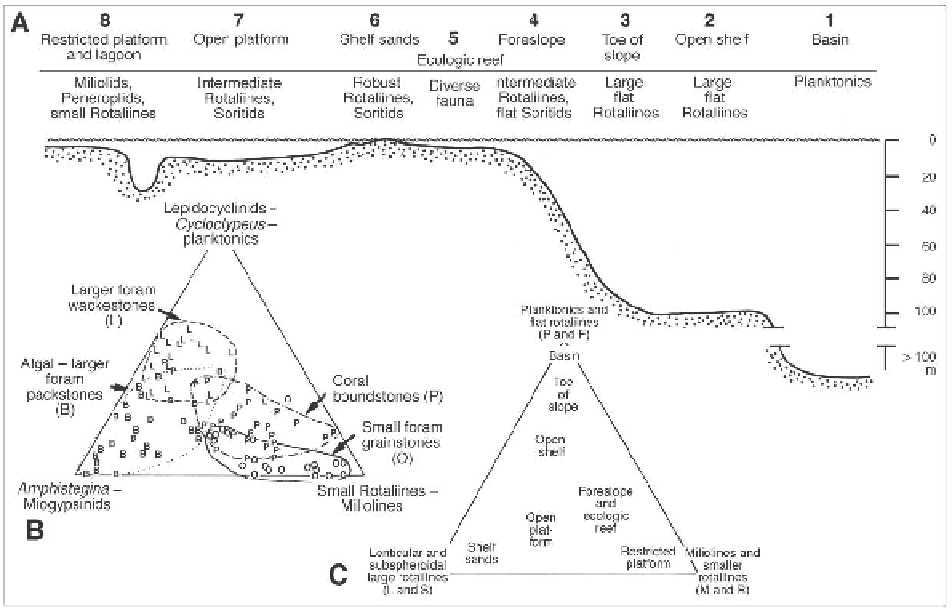Geology Reference
In-Depth Information
Fig. 14.7.
The Standard Facies Zones (FZ) differentiated by Wilson (1975) for a rimmed carbonate shelf
(Fig. 14.1) are
reflected by distribution patterns of Cenozoic foraminifera. The model developed by Hallock and Glenn (1986) is based on
the relative percentages of three environmentally diagnostic foraminiferal groups (flat, larger rotaliines plus planktonic
foraminifera; lenticular larger rotaliines; miliolinids and smaller rotaliines). The three groups are distinguished by test mor-
phologies, habitats of living relatives and R-mode multivariate analysis. All the foraminifera belonging to these categories
are counted in thin sections and the proportions are plotted in triangle diagrams.
A:
Idealized distribution of Tertiary diagnostic foraminiferal groups in sediments of the standard facies zones FZ 1 to
FZ 8 across a platform-basin transect with marginal reefs. Water depths are derived from modern data.
B:
Triangle diagram of four foraminifera assemblages in a core comprising Early Miocene reef-associated wackestones,
packstones, grainstones and boundstones. The diagram indicates water depth, wave energy, and open marine depositional
environments of the assemblages. Shallow-water, high energy conditions are indicated for faunas plotting to the lower left.
Assemblages of protected environments plot to the lower right and deeper open-marine conditions toward the apex.
C:
Triangle diagram summarizing where foraminiferal assemblages from each of Wilson's Standard Facies Zones FZ 1-
FZ 8 would generally plot. B and C: Modified from Hallock and Glenn (1986).
tary and paleontological criteria that allow water en-
ergy and water depth to be interpreted. Figs. 14.8 to
14.11 demonstrate an example for facies zones occur-
ring in Devonian reef, platform and ramp settings.
transported and resedimented tests, and autochthonous
assemblages to be differentiated (Gischler 2003).
Unlike rimmed platforms, the
biotic composition of
homoclinal carbonate ramps
appears rather homoge-
neous, and lateral changes are often gradual, specifi-
cally in outer ramp environments. In these environments
Standard Microfacies Types are of limited value. Ramps
can be differentiated if the lateral and vertical distribu-
tion of microfossil assemblages and their shifts are used
as the main criteria. The shifts can be used to recognize
sequence stratigraphic boundaries and maximum flood-
ing surfaces in deeper-water ramps. This is interesting,
because in deep and relatively constant outer ramp en-
vironments, sequence stratigraphic transitions are very
subtle and the boundaries of system tracts tend not to
occur as unconformities at the contact of units. For us-
ing
microfossil assemblage
s see Fig. 14.12.
Distribution of benthic assemblages along shallow
marine to deeper marine transects:
The composition
of benthic assemblages varies in different parts of car-
bonate platforms and ramps. Compositional differences
in
shallow platforms
occur on a species level (e.g. for
foraminifera, mollusks, and green algae) as well as on
a statistically based ecologically defined group level
(e.g. reaction groups, Purdy 1963).
Benthic foraminifera have been successfully used
as facies indicators in modern and ancient carbonates
(Murray 1991). The consideration of textural param-
eter of foraminiferal tests (grain size, sorting) allows
Text continued on p. 676

